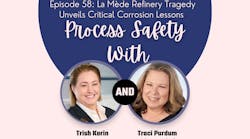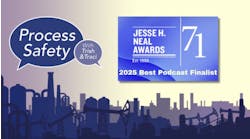La Mède Refinery Tragedy Unveils Critical Corrosion Lessons
In the podcast episode, Traci and Trish discuss the 31st anniversary of the La Mède Refinery explosion in France, detailing the events and the consequences, including six fatalities and significant financial loss. Trish emphasizes the importance of rigorous corrosion inspection programs and the need for comprehensive risk assessments in facility design. They explore legal implications, questioning the attribution of blame to specific individuals. The conversation shifts to the need for explosion-proof control rooms and considerations for retrofitting existing facilities. Traci raises the importance of space between units to prevent a domino effect during explosions, and Trish highlights various mitigation measures, including advanced firefighting techniques and vapor barriers. The episode underscores the continual evolution of safety technologies and emphasizes the importance of embracing new developments to enhance facility safety.
Transcript:
Traci: In today's episode, we recently observed the 31st anniversary of the explosion that occurred at the La Mède Refinery in the south of France on Nov. 9th, 1992. As a result, six people died, dozens more were injured, and there was a financial loss of about $600 million. Can you tell us a little bit about what happened that day?
Trish: Certainly. So, it was a standard fuel refinery. It had a range of different refining assets or utilities around the place. So, they had a fluidized catalytic cracker as part of that particular facility, as well as a number of other crude units, reformers, et cetera. And what occurred that day was there was actually quite a significant release of a flammable substance that occurred at almost about 5:20 in the morning. Then that subsequently set off some gas detector alarms that said there had been a release. But by the time the operators responded to it, and they responded very quickly, this thing got out of control incredibly quickly; there was an ignition source thought to be from a nearby heater. And so corrosion had caused a release from a pipeline on one of the strippers that had caused this massive explosion and subsequent explosions that resulted in, as you said, tragically the loss of six people. But also, some substantial equipment damage occurred that day. It was said that the explosion could be heard and seen and felt for kilometers away.
Traci: An expert witness had claimed that the corrosion was foreseeable, pointing to the conclusion that management and maintenance were negligent. In 2002, the then president was found guilty of involuntary manslaughter, and two inspection managers and two plan inspectors were also sentenced. What are your thoughts on that?
Trish: Yeah, so this is an interesting one. The fact is that the hazard of corrosion is present in our facilities. We need to understand the metallurgy or the material of construction that we do have in our facilities. We need to understand how the substances inside those pipes react with that material. Also, understanding things like corrosion under insulation, which is external corrosion that will occur, but we can't see it because it's covered by insulation typically. So we do need to have some very structured and rigorous corrosion inspection programs because the fact is that corrosion is a foreseeable hazard. We know corrosion occurs. It's a simple law of chemistry that we can't get around. So we do need to make sure that we're adequately inspecting, and that includes not only understanding the materials but understanding the history of our facility. Are we seeing accelerated corrosion in some areas and not in others?
Understanding the science of corrosion maintenance program and making sure that we are inspecting the right areas in our plant because corrosion will be prevalent in some more areas than others. We also need to understand a range of other things like erosion that also does occur as the product flows through the pipeline. It's a different mechanism to corrosion, but it creates effectively the same issue coming out the other end, where we thin the material that's containing our product, and then it's thinned so much it can no longer contain the pressure and it's released. Now, the president was found guilty. The president and the company was found guilty in a court of law for being negligent in this instance. I think that's an interesting turn of events that has taken place, and one would question the different people that were found guilty in this particular instance because it was quite spread out throughout the organization.
The plant inspector, whilst they're the ones out there actually inspecting and doing the work, how much control do they actually have with budgets potentially being set levels above them, setting the budgets not only for the inspection but also for necessary replacement work. So, I think there's... We need to be aware of if we're going to go down that legal pathway, making sure that it's just in what we do. Organizational factors lead to a lot of things occurring in an event, and I think we need to be very careful about laying the blame at specific individuals for an incident. So obviously, a court of law in France did deem that they were guilty of negligence, but I think we need to be a bit careful about pointing fingers and laying blame. It doesn't necessarily help us fix the problem and get better at it in the future.
Traci: We've talked about... In many of our episodes, we've talked about control rooms and how they need to be bolstered to be able to withstand explosions. It seems to be the case here, too. Can and should control rooms be mandated to be explosion-proof?
Trish: That's a very interesting question, Traci. You always give me some really good ones. Don't you? Look, I think we need to do detailed occupied building risk assessments to determine the consequence and what could actually happen if there is a credible explosion in a particular part of a facility. And ultimately, if you then do your risk assessment and that risk is intolerable, you have to do something about it. You need to be moving people to an area where you can actually protect them. Now, there are a number of ways to bolster different buildings as well. It doesn't necessarily mean you have to knock everything down and go and rebuild a big concrete bunker hundreds of yards away and all that sort of stuff because that potentially introduces some other issues of, when the operators are so remote from the plant, how do they then respond to what's going on? I think we need to have a balanced approach.
We do need to use risk assessment processes to do that, and there is some well-established guidance from API on occupied building risk assessments. I think one of the key things we need to keep in mind when we do occupy building risk assessments is that we don't make the assumption of our building occupancy based on normal operation, because chances are, if we're in an abnormal operation situation, we probably then often have more people in the area. So, we need to make sure that it's a valid assessment for the number of people that we could have impacted in this, and then make sure we adequately protect them. We can protect them by a range of different means. We could do things like just blast walls that are going to protect a building, or even just armoring the building so that at the end of the day, the building is going to be demolished, but it stands enough to keep the people inside it safe to deal with the initial emergency until they then evacuate.
So there's a range of different options that can be done, as well as there's certainly some very high-quality options in terms of container placement and reinforced containers I know that are on the market now. Particularly in the US, I've seen a lot of those. So, there's a lot of different options that we can look at here. We need to make sure that not only do we just focus on the building, but the services that are feeding that building, so air systems into it, the electricity supply into it so that we can maintain control, the instrumentation lines going in and out of it so that we'd still do have control of what's going on, and then looking at how other parts of the facility could be impacted. In this instance as well, basically, the explosion took out the flare system. And so the fire brigade made the decision to actually control burn some of the facility because they couldn't adequately blow down hydrocarbons that were still in the line.
Traci: One of the lessons learned that I read about while I was studying for this podcast was to keep enough space between units to avoid any domino effect and to allow easier access to emergency services, and I think that's kind of what you were getting at. What happens when this isn't always possible to have that space between units?
Trish: Yeah, so if we were designing a plant from first principles from scratch and we have our blank piece of paper, we can choose, first of all, the important part of inherently safer designers. Are we choosing the right technology to put in the first place? Are we choosing the more inherently safer design technology to put in? Once we've made a determination of what technology we want to put in, then we actually do need to look at how it's laid out. And if we're working on a blank sheet of paper, we can lay things out in a beautiful manner, lovely separation distances, lovely access roads, all sorts of fabulous stuff. Except we don't build a lot of brand new plants anymore. We are stuck with a lot of old plants. And in some instances where if there's a gap in a plot of land, something gets put in it, and things continually get built up.
So the reality is we have a lot of congested facilities around the world, and that means we need to think a little bit differently about how we do things. So it could be things like vapor barriers to prevent leaks and vapor clouds moving into other areas of the plant. It could be things like explosion walls to prevent an explosion propagating further and that domino effect occurring. It could be things, such as automated detection systems that... There's been a lot of work done recently on the development of... They're like firefighting monitors, but they actually spray out a chemical that knocks down the vapor cloud before it can have an ignition source. So it requires a lot of detection of what's going on and making sure your detectors are in the right spot, and then it responds very, very quickly so it can actually blow out this chemical that prevents an explosion occurring because it's completely removed the flammable vapor.
So there's a whole lot of different things we can be doing, even in our current congested sites, that we really need to be thinking about and making sure that we are applying good principled risk management design in what we're doing.
Traci: You brought it up the detectors. What about gas detectors and sprinkler systems? Other things? Are there other things that we should be thinking about as well?
Trish: Obviously, the need to have good gas detection is critical in this instance. Keep in mind we're only talking about the right-hand side of the bow tie here, though. We're talking about the mitigation and the emergency response when we're talking about gas detectors, sprinkler systems to knock down vapor clouds, other particular chemicals that can knock down vapor clouds, but that's still the mitigation. We need to also remember we need to make sure we don't have the corrosion in the first place, putting a hole in the pipe. So I just want to make that point again: keeping containment and keeping control of our systems that deal with our containment is what we actually have to do first. That's the most important part. Then if something does happen, how we respond is equally as important. So there is a range of different, as I said, new firefighting techniques, new prevention of vapor cloud techniques that a lot of work has been done on around the world, and there's really some quite interesting new developments out there with these.
As I said, I've seen video of them, these massive cannons that just shoot out this chemical powder that effectively destroys the vapor cloud, so it can't ignite them. It's not just only using the same tools and techniques that we've always used. New developments are happening all the time. And we need to be looking at those and seeing, does it make sense in our facility to actually put them in place?
Traci: Trish, is there anything you'd like to add to this topic?
Trish: I think the key point for me here is just really focusing on what are the new developments out there, and how can we implement those in our facilities to keep our people and our facilities safer? We work in a hazardous environment. We face a range of hazards every day. We practice risk management to control those hazards. When something does go wrong, we need to be able to respond, and we need to be willing to go back and reassess and say, "Do we need to put in place some additional control measures because technology's improved, and they're now available to us?" These technologies weren't available back when this event happened in 1992, but they are now. So we should be looking. If you are running a refinery or a facility that could have a large vapor cloud, what are you doing to understand?
Do you have the right level of fry protection that's available with the technology we have today? Not just because it was right and it met the standard or the code when it was installed. That's actually not morally good enough in what we do. We need to be looking to what we do to reduce the risk, not just to tick a box on a code that now may be quite out of date. So it's really embrace risk management and implement effective control measures when they become available to you, rather than rely on the grandfathering of previous codes that are now out of-
Traci: Well, Trish, as always, you help us align our moral compasses and help us pay attention to both sides of the bow tie to keep people safe, and I appreciate that. Unfortunate events happen all over the world, and we will be here to discuss and learn from them. Subscribe to this free podcast so you can stay on top of best practices. You can also visit us at chemicalprocessing.com for more tools and resources aimed at helping you run efficient and safe facilities. On behalf of Trish, I'm Traci, and this is Process Safety with Trish and Traci. Thanks, Trish.
Trish: Stay safe.



